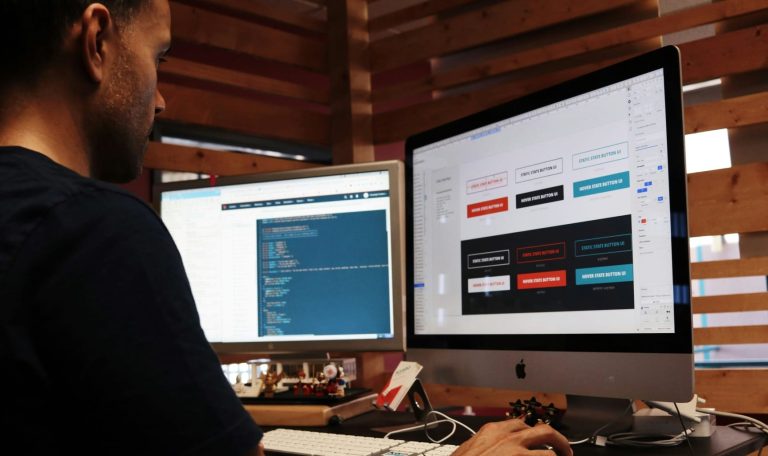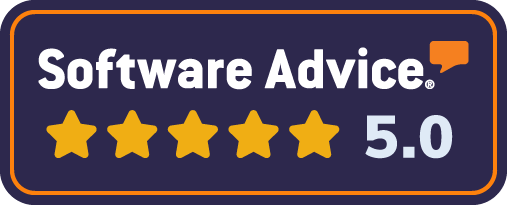Small businesses spend 3-5 hours daily managing social media accounts manually. This time drain prevents owners from focusing on core business operations and growth strategies.
Automated social media marketing changes this reality by handling repetitive tasks like scheduling posts and tracking engagement metrics. We at Emplibot see businesses reduce their social media workload by 80% while maintaining consistent online presence across multiple platforms.
Contents
ToggleWhy Automation Transforms Small Business Marketing
The 80% workload reduction we mentioned happens because automation eliminates the most time-consuming social media tasks. Nucleus Research found businesses achieve a 544% return on investment within three years of implementing marketing automation, with 76% seeing positive results within the first year.
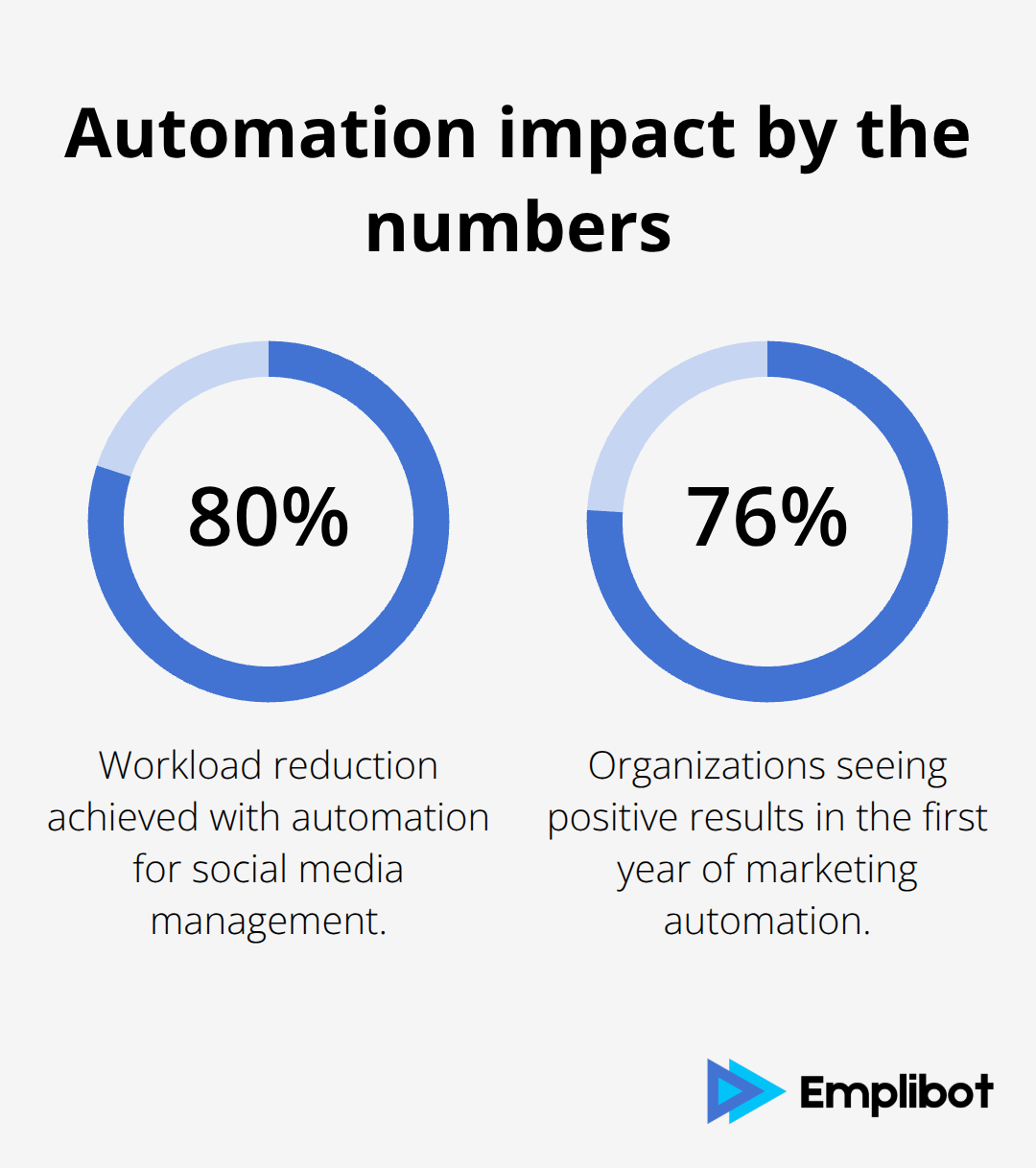
Small businesses using automation tools like Buffer or Hootsuite report saving 15-20 hours weekly on content scheduling alone. Sprout Social documented how Plaid saved 20 hours monthly through strategic automation implementation.
Consistent Posts Without Manual Oversight
Automated scheduling maintains your brand visibility even during weekends, holidays, or busy periods when manual posts become impossible. Hootsuite analyzed 30,000 social media posts and found optimal posting times vary significantly by platform (making manual timing nearly impossible to master). Automation tools handle these platform-specific requirements automatically. ContentStudio’s Autolists feature lets businesses schedule recurring content collectively rather than individually, perfect for evergreen posts that drive consistent engagement. This consistency builds audience expectations and improves algorithmic visibility across platforms.
Scale Your Reach Without New Hires
Marketing automation allows small businesses to compete with larger companies without expanding their teams. The global marketing automation market grew from $6.65 billion in 2024 to a projected $15.58 billion by 2030, driven primarily by small and medium enterprises adopting these tools. Automated emails generate 320% more revenue than manual campaigns (according to Klaviyo data). Social media automation tools now handle multiple platforms simultaneously, letting one person manage what previously required entire marketing teams.
Focus Resources on Strategy Instead of Tasks
Automation shifts your team’s focus from repetitive tasks to strategic decisions that drive growth. Small businesses typically spend significant time on scheduling and basic management tasks rather than creative strategy development. Tools like Metricool and SocialBee handle routine operations while your team concentrates on campaign strategy and audience engagement. This resource reallocation proves essential as you evaluate which content creation and management tools best support your specific business goals.
Which Tools Actually Deliver Results
SocialBee stands out as the best overall automation platform for small businesses. It combines content calendar management with AI-driven campaign generation. Buffer offers the most user-friendly interface with its AI Assistant that customizes posts for each platform automatically, while Hootsuite provides the deepest template library with over 30,000 analyzed posts that back their optimal timing recommendations.
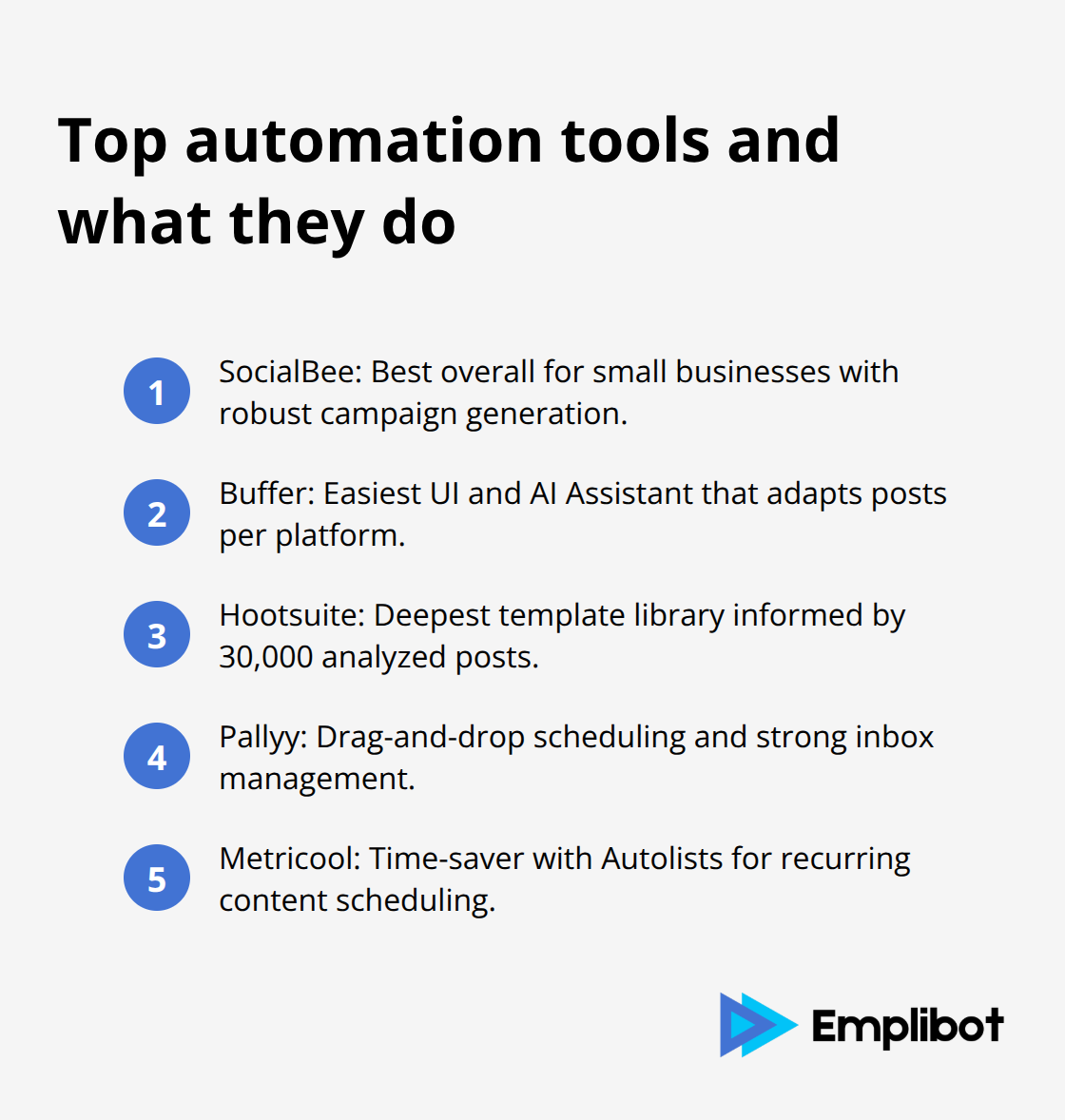
Pallyy excels for content creators with drag-and-drop scheduling and robust inbox management, and Metricool saves the most time through Autolists that schedule recurring content collectively rather than individually.
Analytics That Drive Real Decisions
Iconosquare delivers the most comprehensive analytics with over 100 customizable KPIs for performance tracking. This makes it superior to basic metrics that most platforms offer. ContentStudio tracks engagement metrics across various topics and helps businesses identify which content types generate the highest ROI. Sprout Social costs more but provides advanced bot building capabilities and smart inbox rules that monitor multiple profiles simultaneously. Brand24 specializes in brand mention monitoring with AI-generated sentiment analysis, while Vista Social combines analytics with review management features that most competitors lack.
AI Content Creation Worth Using
Predis.ai generates complete carousels and videos from simple text prompts. This reduces content creation time significantly compared to manual methods, with 88% of marketers using AI daily. Flick serves as an AI copilot that suggests post ideas based on user-defined topics, while FeedHive enables intelligent content recycling with conditional posting rules. Publer integrates text-to-image AI generation directly into the platform, and StoryChief supports multi-channel content creation with strategy generators that maintain consistency across platforms. These AI tools now handle what previously required dedicated design teams, with content creation being the top AI use case among marketers at 43%.
Content Scheduling That Actually Works
Buffer’s AI Assistant adapts your content for each platform’s unique audience requirements. Hootsuite provides editable post templates from their library of 30,000 analyzed posts, while SocialBee automates campaign generation based on your business goals. Metricool’s Autolists feature schedules recurring content in batches rather than one post at a time. ContentStudio offers automated content curation through its Discover tool, which finds engaging content relevant to your industry. These scheduling features eliminate the daily task of manual post creation while maintaining consistent brand presence.
The right tool selection depends on your specific automation needs, but successful implementation requires more than just choosing software. Smart automation strategies balance automated efficiency with authentic human engagement to maximize results.
How to Balance Automation with Human Touch
Apply the 80/20 Rule to Social Content
The 80/20 rule works perfectly for social media automation: automate 80% of your content scheduling and data collection, but keep 20% manual for authentic engagement. 51% of marketers use marketing automation platforms, yet many switch tools because they over-automate and lose personal connection.
Smart businesses automate their evergreen content, educational posts, and promotional materials while manually handling customer responses, trending topic commentary, and crisis communications. Metricool data shows businesses that use this balance see 25% higher engagement rates compared to fully automated accounts.
The key lies in automation of predictable content types while you preserve human oversight for conversations that build relationships.
Track What Matters for Real Growth
Most businesses track vanity metrics like follower counts instead of revenue-driven data. Iconosquare users who focus on conversion metrics rather than engagement rates report 34% higher ROI from their social media efforts.
Monitor your click-through rates to your website, lead generation from social posts, and actual sales attributed to social media campaigns. Sprout Social research indicates that businesses who check these metrics weekly adjust their strategies 40% faster than those who review monthly.
Set up automated reports for engagement data but manually analyze which content types drive the most qualified traffic to your business. Vista Social users who combine automated analytics with weekly manual strategy reviews outperform set-and-forget approaches by significant margins.
Respond Like Humans Not Robots
HubSpot research shows different generations have varying preferences for customer service channels, with many users expecting human-like responses within hours. Agorapulse smart rules help filter urgent messages that need immediate human attention from routine inquiries that chatbots can handle.
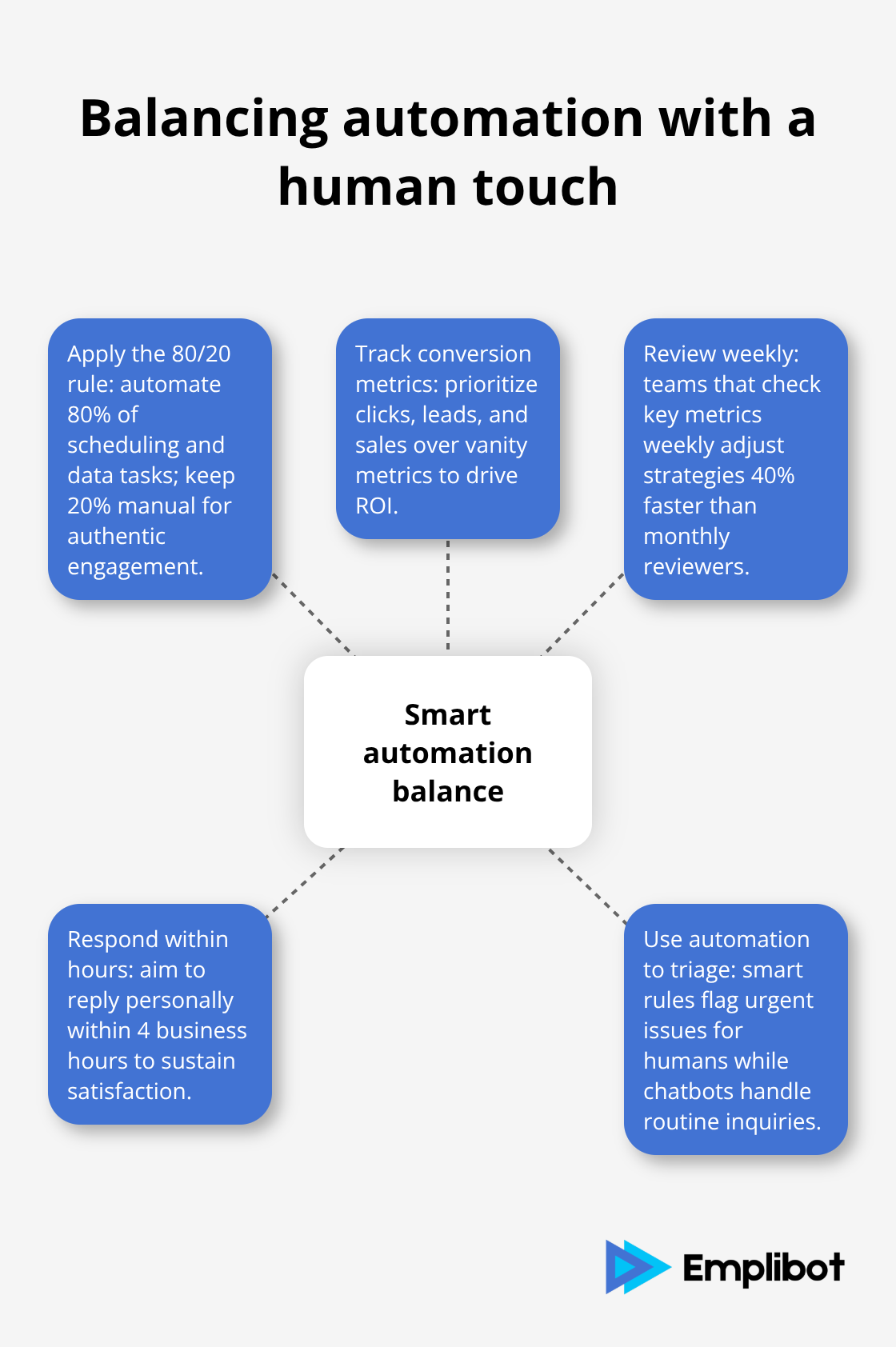
Set up automated acknowledgments for incoming messages, but train your team to respond personally within 4 hours during business days (this timeline maintains customer satisfaction while allowing reasonable response windows). Brand24 sentiment analysis helps identify negative mentions that require immediate human intervention before automated responses make situations worse.
The businesses that thrive use automation to flag important conversations while they maintain genuine human voices in their responses.
Final Thoughts
Automated social media marketing delivers measurable results for small businesses that implement it strategically. The 544% ROI within three years and 80% workload reduction represent real opportunities for growth-focused business owners. Success requires three essential steps: select tools that match your specific needs, implement the 80/20 rule, and track conversion metrics instead of vanity numbers.
The long-term impact extends beyond time savings. Businesses that use automation compete effectively with larger companies without team expansion. They maintain consistent brand presence across multiple platforms while competitors struggle with manual schedules (freeing resources for strategic thinking and creative campaign development).
Smart tool selection combines scheduling platforms, analytics solutions, and content creation systems effectively. Emplibot automates your entire WordPress blog and social media content creation process, handling everything from keyword research to SEO optimization while distributing content across LinkedIn, Facebook, and Twitter. The businesses that thrive in the next decade embrace automation while they preserve authentic human connections with their audiences.

